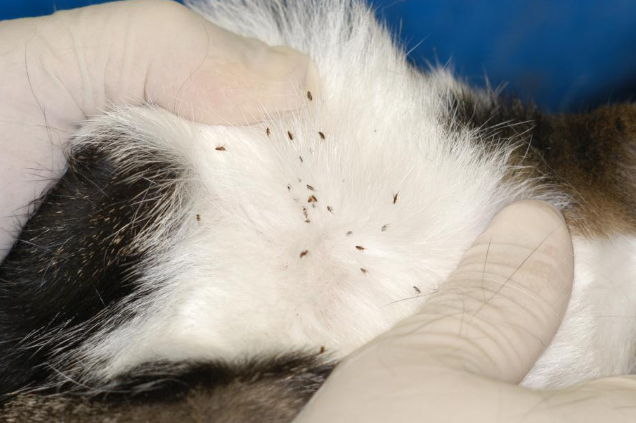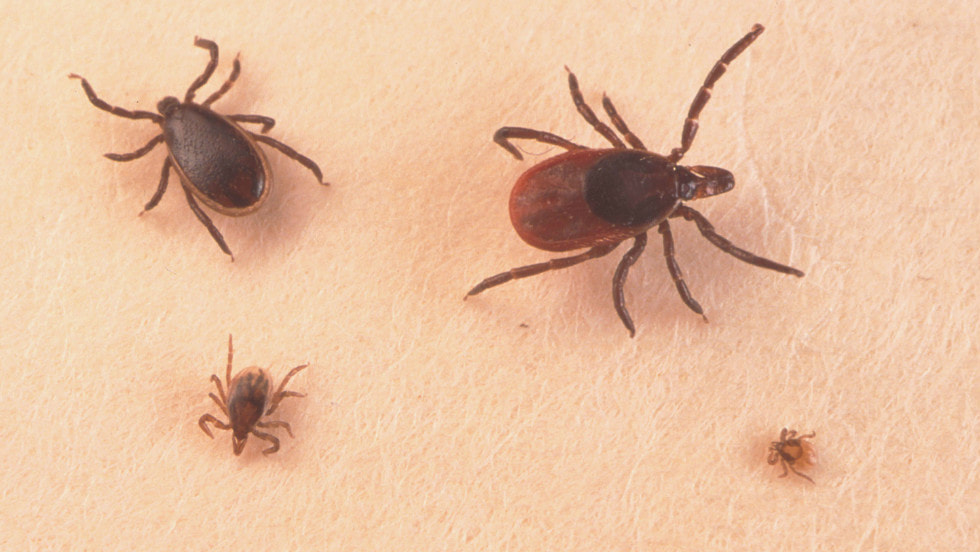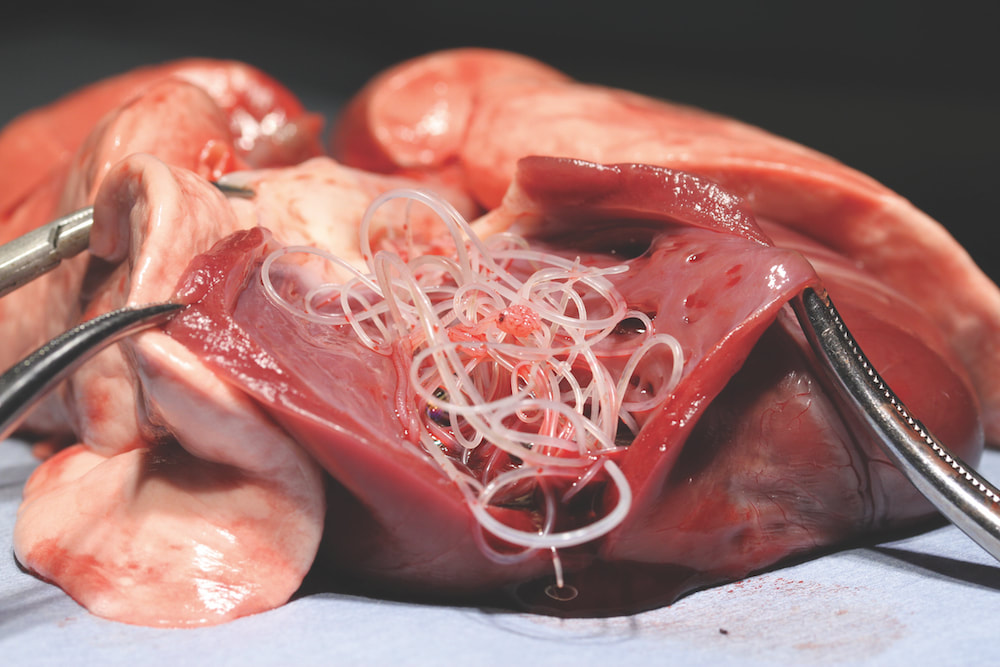Fleas, ticks and heartworm
A frost doesn't kill fleas, ticks or mosquitoes and they can jump to life in 40 degrees or lower. While it's not above 40 degrees 365 days per year, it absolutely gets above 40 degrees every month of the year, which means your pet needs to be on a flea & tick and heartworm preventative all year. Preventing the sometimes deadly diseases these parasites can transmit to your beloved pet is safer, easier and less expensive than treatment. Please give your pets their flea & tick and heartworm preventatives all year round!
Fleas |
Ticks |
Heartworm |
|
What are they? Fleas are small, dark, wingless insects that can jump up to two feet high and feed on blood – we’re both amazed and disgusted by these critters! According to the ASPCA, they can live between 13 days and 12 months and can produce millions of offspring during their lifetime.
|
What are they? Ticks are parasites that happily bury their head into a host’s skin to feed on the blood of a variety of animals, including humans, dogs, cats, rabbits and even lizards. Their unlucky host may never notice that a tick has attached, but ticks can transmit a number of diseases while they are feeding.
|
What are they? Heartworms are parasites common throughout the country. Adult heartworms are approximately fourteen inches long and live in the heart and main arteries of their host. Their presence can obstruct the blood flow and cause inflammation of the arteries, which can be life-threatening if left untreated.
|
|
What diseases do they transmit? Aside from causing skin reactions with their nasty bites, fleas can also carry tapeworm, tularemia, bartonellosis and can cause anemia.
Where will my pet contract fleas? Fleas travel indoors easily. While fleas prefer humid climates and temperatures between 65 and 80 degrees, they can live in temperatures as low as 33 degrees for up to five days! Flea eggs can live year-round in protected areas like crawl spaces or porches. Once inside, flea eggs drop onto rugs, beddings and furniture. An adult female flea can lay up to 50 eggs per day - yuck! How do I know if my pet has fleas? Be on the lookout for droppings or “flea dirt” in your pet’s coat and/or tiny white flea eggs; skin reactions and excessive licking: scratching or biting; hair loss; scabs or hot spots; pale gums or worms in your pet’s stool. If you observe any of these symptoms, call us immediately at 978-369-3505 to make an appointment. We'll prescribe treatment and talk to you about how to rid your pets and your house of fleas. How can I prevent flea-borne illnesses? At CAH we strongly recommend that clients give a flea & tick preventative year round. Fleas can live in temperatures as low as 33 degrees for up to five days, plenty of time to hop a ride on your dog or cat and make a cozy home in your house. Once they become your roommate, the weather outside won't help protect your pets against these critters! Flea eggs can live in protected areas like crawl spaces or porches - freezing temperatures won't always kill these eggs. |
What diseases do they transmit? Ticks carry lots of nasty diseases that can affect humans and our pets, including Lyme disease, ehrlichiosis, Rocky Mountain spotted fever, and anaplasmosis.
Where will my pet contract ticks? Sadly, it’s safe to assume that if you let your pet outside, they are being exposed to ticks. Your pet can pick up ticks in long grass, the short grass in your yard, the woods and even from the brush next to paved surfaces. What do I do if my pet has ticks? Most ticks are visible to the naked eye but can be hard to spot if they’re buried in the fur of your pet. Check your pet for ticks once a day, paying special attention to a tick’s favorite hiding places: between toes, in the "armpits", neck, around the eyes and inside ears. If you find a tick on your pet, remove it as soon as possible. If it hasn’t attached itself yet, there is no risk of tick-borne illness for your pet. If it has attached, grasp the tick with a pair of tweezers as close to the site of attachment as you can and pull straight back. If you have found an attached tick, particularly one that is engorged, the MSPCA advises noting the date and time to discuss with your veterinarian. Continue watching for joint pain, which may manifest as lethargy, lack of appetite, reluctance to stand or lie down, crying painfully, walking gingerly or limping, especially on more than one limb or on a different limb from one day to the next. NOTE: Symptoms may not appear until several weeks after exposure. If you observe any of these symptoms following a tick bite, contact us immediately to make an appointment. Typically tick borne-illnesses respond well to a course of antibiotics, so don’t delay in contacting us! How can I prevent tick-borne illnesses? At CAH we take a multi-pronged approach to protecting your pets from tick-borne diseases like Lyme and anaplasmosis. We vaccinate dogs against Lyme disease, test all at-risk pets for tick-borne diseases annually and we strongly recommend that clients give a flea & tick preventative year round. Ticks aren't killed by the frost and jump to life when it's at least 40 degrees. While it's not above 40 degrees 365 days per year, it absolutely gets above 40 degrees every month of the year. |
Where will my pet contract heartworm? Mosquitoes feed on an animal infected with heartworms, picking up heartworm larva and transmitting to another animal. The immature heartworms migrate in the tissues of a host for several months before entering the blood stream and traveling to the heart. They will reach the heart about 6-7 months after the mosquito first infects the host.
What are signs of heartworms? Signs of heartworm disease vary from no symptoms to severe heart and lung disease. You may observe coughing, exercise intolerance, shortness of breath or difficulty breathing in your dog. How can I prevent heartworm? Prevention is dramatically safer (and less expensive) than treatment and is simple. We’ll want to test your dog for heartworm before starting or restarting your dog on heartworm preventatives. If your dog is negative, we recommend taking a monthly preventative to kill the immature stages of heartworms before they reach the heart. Most heartworm preventatives have the added benefit of killing other common parasites such as roundworm and hookworm. For more information about heartworm disease please visit heartwormsociety.org |



